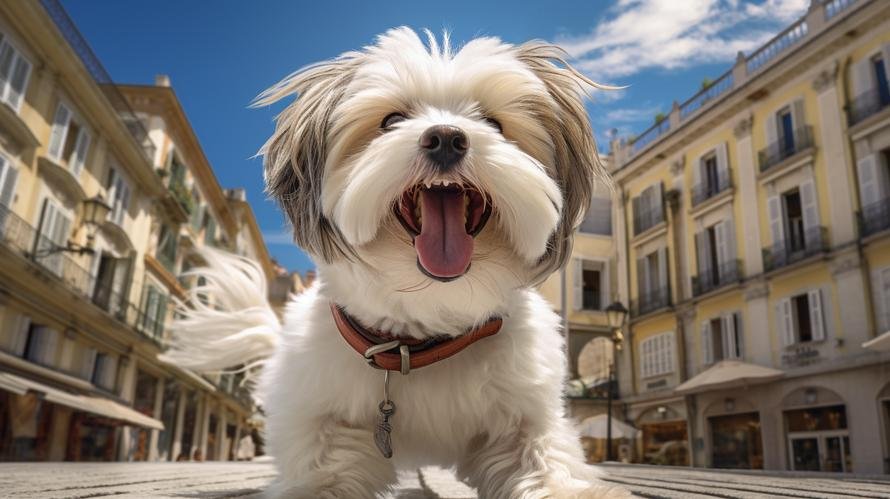The Havanese dog breed hails from the sunny land of Cuba, a nation known for its vibrant culture, soulful music, amazing cuisine, and some of the world’s friendliest dogs!
The aura of the Havanese is infectious. Their charm is undeniable, their spirit relentless and their love, unconditional. But beneath that adorable exterior, are they potentially dangerous? Today, we delve into the world of the Havanese breed to uncover any lurking threats. Hold on to your leashes, folks!
Havanese dogs are small, friendly creatures that have been winning hearts worldwide. As members of the Bichon family, they exhibit a coat that is as breathtaking as the Caribbean beaches they originate from. Combine this striking aesthetic with a delightfully lovable personality and you’ve got a premium contender for the world’s most affable dog breed.
However, every dog breed has its quirks. This does not exempt the Havanese. The term ‘danger’ can be quite relative and subjective when it comes to its application on dogs. Usually, danger from a dog comes from its size, temperament, and upbringing. So, to cast a fair judgment, let’s explore these aspects minutely!
The typical Havanese is small — 8.5 to 11.5 inches tall and weighs in between 7 to 13 pounds. With a size that’s perfect for carrying in your arm or cosying up in your lap, it’s safe to state that a Havanese is unlikely to pose a physical threat due to size. However, this doesn’t put them completely in the clear. A punch isn’t the only way to hurt, even a small dog can pose a ‘danger’ when they harbour behavioural issues or temperament problems.
When we breach the subject of temperament, the Havanese sways more towards the safer side of the spectrum. They’re social butterflies, eager to greet everyone they encounter with an enthusiastic wag and a kiss if you’re lucky! Their sociable nature, combined with an innate sense of playfulness, creates an energetic character that’s generally forgiving and seldom aggressive. They’re inherently good-natured and typically demonstrate exceptionally amiable behaviour.
Despite their congenial disposition, it’s important to note that these dogs have a sensitive side too. They don’t fare well under harsh treatment or rugged environments which can trigger abrupt behavioral changes. So, negativity around your Havanese may induce anxiety, fear, or aggression, jeopardizing their usually sunny disposition. But then again, this is common trait among all dog breeds. A hostile environment can transform even the sweetest of pups into an anxious or defensive creature. Therefore, the danger is not inherent to the breed, but rather related to the kind of upbringing and environment they’re subjected to.
As we turn the page into upbringing, the correlation between a dog’s rearing and their behavioural output becomes evident. Like kids, dogs are greatly influenced by their environment and the kind of care they receive. The sweeter the care, the sweeter the dog. The Havanese breed is no exception. They are highly trainable and moderately intelligent, making achieving good behavior relatively easy in comparison to more stubborn or independent breeds. Training that incorporates positive reinforcement techniques reaps the best results, producing a well-behaved, good-natured Havanese. Neglect or mistreatment, however, can sprout destructive tendencies in the dog, making this the only plausible ‘danger’ associated with this breed.
In the world of dogs, the words ‘dangerous’ and ‘aggressive’ are frequently used interchangeably. Aggression is a natural instinct present in almost all animals, a survival mechanism activated in response to a gauged threat. Aggression in dogs manifests as barking, growling, and biting, behaviors that often misconstrue them as dangerous. The Havanese breed exhibits a low aggression propensity, unlikely to evoke such responses in an offensive manner. However, they may naturally act defensive when they feel threatened, but this applies to virtually all breeds.
To sum it up, a dangerous dog is often the product of mistreatment, poor training, and a rough environment. Looking at the Havanese under a fair lens, we find that they are more lover than fighter. While they can be fearful or anxious when provoked, they are not inherently aggressive or dangerous.
Perhaps the only person who might perceive a Havanese as ‘dangerous’ is the postman — they make excellent watchdogs and may defend their territory with intense barking. An intimidating sight? Definitely not, but it’ll surely startle anyone bold enough to knock on the door unannounced!
Nevertheless, adopting any dog comes with responsibilities. The Havanese is a loyal, good-hearted creature that’ll love you with all it’s got. All they ask in return is kind treatment, appropriate training, and lots of cuddles. Maybe the real question we should be asking is not if a Havanese is a dangerous dog, but rather how we, as pet parents, can ensure a secure, nurturing environment for our furry friends.
A dog will mirror the love you shower upon it. The Havanese breed, with its insatiable spirit and irrefutable charisma, is no exception. Kept under the right conditions, lovingly cared for and properly trained—every Havanese can optimise their potential to be a lovable companion and a beacon of joy. Rather than worrying about the dog being a danger, the focus should lie in making sure we are not a danger to them!



